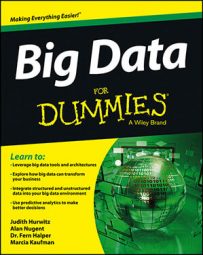As computing moved into the commercial market, data was stored in flat files that imposed no structure. Today, big data requires manageable data structures. When companies needed to get to a level of detailed understanding about customers, they had to apply brute-force methods, including very detailed programming models to create some value.
Later in the 1970s, things changed with the invention of the relational data model and the relational database management system (RDBMS) that imposed structure and a method for improving performance. Most importantly, the relational model added a level of abstraction so that it was easier for programmers to satisfy the growing business demands to extract value from data.
The relational model offered an ecosystem of tools from a large number of emerging software companies. It filled a growing need to help companies better organize their data and be able to compare transactions from one geography to another.
In addition, it helped business managers who wanted to be able to examine information such as inventory and compare it to customer order information for decision-making purposes. But a problem emerged from this exploding demand for answers: Storing this growing volume of data was expensive and accessing it was slow. Making matters worse, lots of data duplication existed, and the actual business value of that data was hard to measure.
When the volume of data that organizations needed to manage grew out of control, the data warehouse provided a solution. The data warehouse enabled the IT organization to select a subset of the data being stored so that it would be easier for the business to try to gain insights.
The data warehouse was intended to help companies deal with increasingly large amounts of structured data that they needed to be able to analyze by reducing the volume of the data to something smaller and more focused on a particular area of the business. It filled the need to separate operational decision support processing and decision support — for performance reasons.
Warehouses often store data from prior years for understanding organizational performance, identifying trends, and helping to expose patterns of behavior. It also provided an integrated source of information from across various data sources that could be used for analysis. Today, both content management systems and data warehouses are able to take advantage of improvements in scalability of hardware, virtualization technologies, and the ability to create integrated hardware and software systems.
Sometimes these data warehouses themselves were too complex and large and didn’t offer the speed and agility that the business required. The answer was a further refinement of the data being managed through data marts. These data marts were focused on specific business issues and supported the business need for speedy queries. The warehouse has evolved to support emerging technologies such as integrated systems and data appliances.
Data warehouses and data marts solved many problems for companies needing a consistent way to manage massive transactional data. But when it came to managing huge volumes of unstructured or semi-structured data, the warehouse was not able to evolve enough to meet changing demands.
To complicate matters, data warehouses are typically fed in batch intervals, usually weekly or daily. This is fine for planning, financial reporting, and traditional marketing campaigns, but is too slow for increasingly real-time business and consumer environments.
How would companies be able to transform their traditional data management approaches to handle the expanding volume of unstructured data elements? The solution did not emerge overnight. As companies began to store unstructured data, vendors began to add capabilities such as BLOBs (binary large objects).
In essence, an unstructured data element would be stored in a relational database as one contiguous chunk of data. This object could be labeled but you couldn’t see what was inside that object. Clearly, this wasn’t going to solve changing customer or business needs.
Enter the object database management system (ODBMS). The object database stored the BLOB as an addressable set of pieces so that you could see what was in there. Unlike the BLOB, which was an independent unit appended to a traditional relational database, the object database provided a unified approach for dealing with unstructured data.
Object databases include a programming language and a structure for the data elements so that it is easier to manipulate various data objects without programming and complex joins. The object databases introduced a new level of innovation that helped lead to the second wave of data management.

